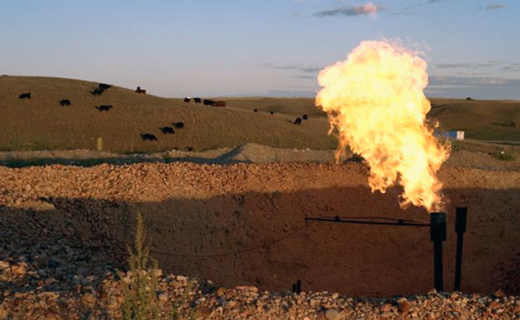
WASHINGTON (AP) – With real-time monitors, scientists have linked a swarm of small earthquakes west of Fort Worth, Texas, to nearby natural gas wells and wastewater injection.
In 84 days from November 2013 to January 2014, the area around Azle, Texas, shook with 27 magnitude 2 or greater earthquakes, while scientists at Southern Methodist University and the U.S. Geological Survey monitored the shaking. It’s an area that had no recorded quakes for 150 years on faults that “have been inactive for hundreds of millions of years,” said SMU geophysicist Matthew Hornbach.
When the volume of injections decreased significantly, so did the shaking.
The scientists concluded that removing saltwater from the wells in the gas production process and then injecting that wastewater back underground “represent the most likely cause” for the swarm of quakes, according to a study published Tuesday in the journal Nature Communications.
The scientists determined this based on where and when the earthquakes happened; computer models that track pressure changes; and company data from nearby wells. Hornbach said the timing and location of the quakes correlates better to the drilling and injection than any other possible reason.
“There appears to be little doubt about the conclusion that the earthquakes were in fact induced,” USGS seismologist Susan Hough, who wasn’t part of the study team, said in an email. “There’s almost an abundance of smoking guns in this case.”
This adds to other studies that linked injecting wastewater from energy wells to a tremendous jump in earthquakes in Oklahoma and southern Kansas, where there have been more than 950 magnitude 2 or higher quakes so far this year, according to the USGS.
On Tuesday, the Oklahoma Geological Society said it is “very likely” that most of the earthquakes that have shaken the state in recent years have been triggered by the subsurface injection of wastewater from oil and natural gas drilling operations. The society released a statement following an investigation into dozens of earthquakes recorded in central and north-central Oklahoma.
Unlike other research that linked quakes to the injection of wastewater, the SMU study also sees a secondary link in another part of the drilling process, when massive amounts of brine is taking out of the ground with the gas, said study co-author William Ellsworth of the USGS. Removing the saltwater changes the underground pressure, Hornbach said.
But the deep injection of the wastes still is the principle culprit, Ellsworth said. The controversial method of hydraulic fracturing or fracking, even though that may be used in the drilling, is not physically causing the shakes, he said.
The findings come amid heightened debate over oil and gas regulations, including efforts in some communities to ban drilling. In Texas, lawmakers are considering bills that would limit cities’ abilities to do so.
The Texas Railroad Commission, the state’s oil and gas regulator, hired its first seismologist last year to investigate potential links between quakes and fracking after Azle residents asked the agency to halt oil and gas activities. The seismologist has not offered any conclusions.
Meanwhile, SMU seismologists are still examining the cause of ongoing earthquakes in suburban Dallas. In February, researchers released preliminary results that showed a narrow fault line extending from Irving to West Texas. Researchers previously identified disposal wells as the source of seismic activity at the Dallas-Fort Worth International Airport.
Photo: Fracking operations at the Eagle Ford shale in Texas. | Sarah Christianson/EcoWatch










